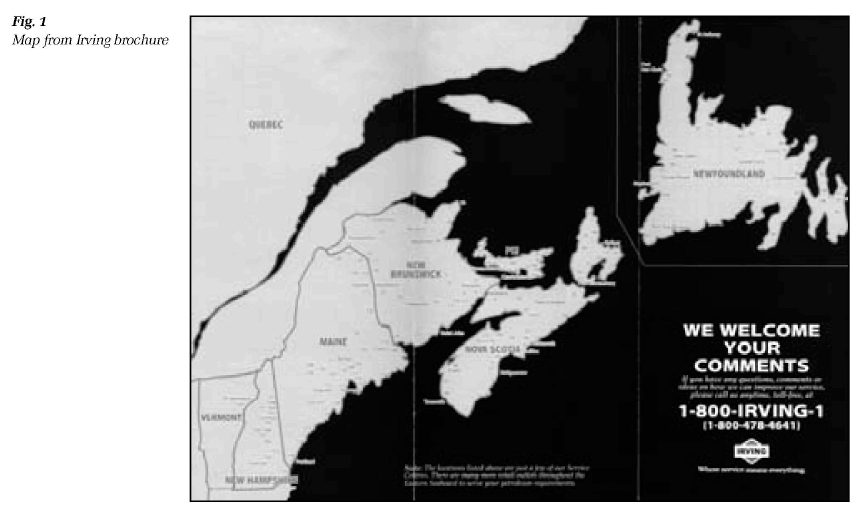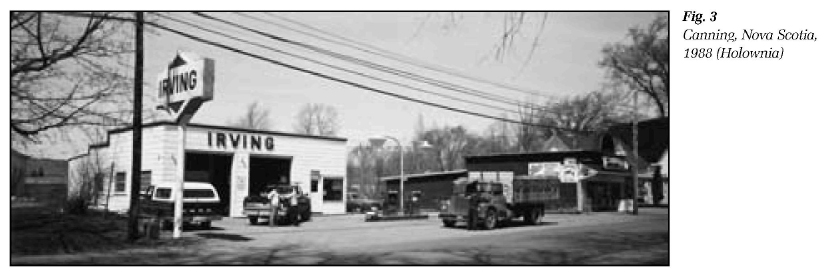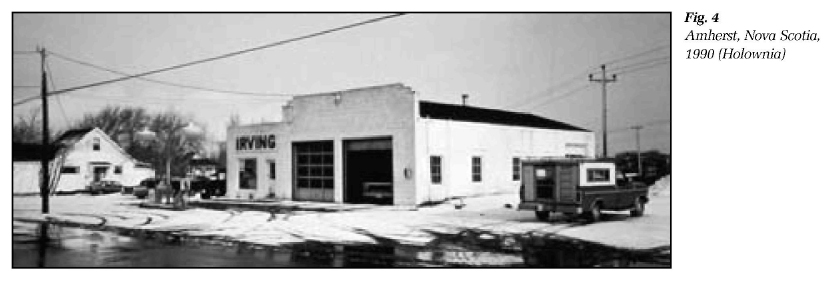Abstract
Among the best sources on the architecture of early Irving gas stations are seventy gelatin silver and chromogenic contact photographs by well-known Canadian photographer Thaddeus Holownia. He began to document Irving stations in 1982, following a move to Sackville, New Brunswick, from Toronto four years earlier. Holownia’s work has much to teach scholars of vernacular architecture. Although few of the photos include people, we sense human activity through open doors, adjacent houses, parked pickups, tracks in the snow, power lines, and advertising. Holownia’s view of the formal diversity of rural gas station is not the sanitized picture of Modernism we typically find in architectural history books. It is, perhaps, a more vernacular vision, like the work of American photographer Walker Evans and the German partnership Bernd and Hilla Becher, to whom his work is often compared. It is also a unique registry of how corporate capitalism can unexpectedly create a local vernacular architecture.
Résumé
Parmi les meilleures sources d’information sur l’architecture des premières stations-service Irving, on compte 70 épreuves argentiques à la gélatine et épreuves-contacts chromogéniques du réputé photographe canadien Thaddeus Holownia. Celui-ci a commencé à photographier les stations Irving en 1982, quatre ans après être déménagé de Toronto à Sackville (Nouveau-Brunswick). Son travail en apprend beaucoup aux chercheurs qui s’intéressent à l’architecture vernaculaire. Même si peu de ses photos montrent des personnes, l’activité humaine se décèle dans les portes ouvertes, les maisons adjacentes, les camionnettes stationnées, les traces dans la neige, les lignes de transport d’électricité et la publicité. Le point de vue d’Holownia sur la diversité formelle des stations-service rurales n’est pas l’image aseptisée habituelle du modernisme des livres d’histoire de l’architecture. C’est peut-être une vision plus vernaculaire, à l’instar des travaux du photographe américain Walker Evans et des Allemands Bernd et Hilla Becher, à qui celui d’Holowina est souvent comparé. C’est aussi un inventaire sans pareil des façons dont l’entreprise capitaliste peut, contre toute attente, créer une architecture vernaculaire locale.
1 Irving Oil Limited has played an important role in forming the cultural landscapes of Canada’s eastern-most provinces. Irving Oil’s building projects include the country’s largest oil refinery (built in 1960, expanded in 1971), as well as Canaport, the first deep-water terminal in the western hemisphere (opened in 1970), both in Saint John, New Brunswick. The sheer power of Irving Oil is also legible in the breadth of its holdings. In the "golden age" of gasoline, the notoriously secretive, family-owned corporation founded by K. C. Irving in 1924 employed 8 percent of the province of New Brunswick in its vast empire of oil, building products, shipping, lumber, printing and food processing. By 2003 the company boasted 864 of the country’s 12 000 (7 percent) gasoline outlets.2
2 This short paper explores Thaddeus Holownia’s series of photographs of Irving gas stations from the 1980s and 1990s, "Irving: Architectural Landscapes." The examination of the images provides three pointed lessons for our evolving understanding of Irving’s contribution to the material culture and vernacular architecture of Atlantic Canada. Firstly, by presenting Modernist architecture as a setting for human action, his photographs counteract the widespread but false preservationist idea of life in New Brunswick and Nova Scotia. Secondly, the formal diversity of the service stations captured in Holownia’s photographs causes us to reconsider our presumptions about the architecture of multinational corporations. Finally, Holownia’s pictures have much to teach us about how corporate capitalism can unexpectedly create a local vernacular architecture.
3 Maps of the Atlantic provinces and northern New England states illustrate the extent of Irving’s architectural, visual, and cultural presence (Fig. 1). Nearly every small town in eastern Canada boasts an Irving outlet and nearly every port is "decorated" by large Irving oil containers.3 Indeed, a key to Irving Oil’s early and ongoing success as a corporation is its vertical integration, the acquisition of a series of companies that allows direct control of all phases of oil production through to delivery to the consumer, including bus and truck companies and the Saint John Shipbuilding and Dry Dock Company. Domestic oil tanks, eighteen wheelers, and even dories sport the ubiquitous Irving logo.
4 A striking and important architectural fallout of Irving’s corporate gigantism is the construction of hundreds of unabashedly Modern gas stations in a region known for its traditional, picturesque vernacular.4 Most Irving stations are white, boxy buildings, with flat roofs and large expanses of glass (Fig. 2), following the precepts of so-called International Style modernism. Named for the famous exhibition of industrially-inspired architecture held at the Museum of Modern Art in New York in 1932, International Style architecture followed the revolutionary ideas of Swiss architect Le Corbusier and the principles espoused at the German design school, the Bauhaus. Its influence on North American architects, however, was not felt deeply until the 1950s.
 Display large image of Figure 2
Display large image of Figure 25 Irving stations typically included a one- to three-bay garage with rolling glass doors, adjacent to a small office or store, legible by its separate entrance and big windows. The "trade dress" of the Irving company is the red and white fascia and the red-painted "islands" holding the gas pumps. Some stations still boast the rather handsome silhouetted name of the company, called out in straightforward capitals. Other typical features of these Modernist Irving stations include the dealer’s name above the door and a stone "foundation" with black grout.5 Large and clean washrooms, accessible from outside only, were also a special design feature of Irving stations, perhaps intended to distinguish themselves from competitors.6
6 By documenting the Modernist Irving stations in a compassionate way, Holownia’s photos counteract the widespread but false preservationist image of life in New Brunswick and Nova Scotia.7 For example, many of Holownia’s pictures feature displays of tires, window washer fluid, and oil for automobiles outside the stations, the material culture associated with selling gasoline. The inclusion of these artifacts gives the sense of a unique, ephemeral and authentic moment in time, such as his image of Canning, Nova Scotia (Fig. 3), featuring the monumental garage doors open, ready to admit a truck. And like the great yawning garage door, open hoods of cars and trucks remind us of the internal workings of motor vehicles. The precise movement of the truck in Holownia’s photo of Amherst, Nova Scotia (Fig. 4), too, is legible in the web of tire tracks left in the snow. The framing of adjacent houses, powerlines, and advertising implicates the individual gas station in a larger network of human activity.
7 The ways that cars can connect people is also a central theme in the historiography of vernacular architecture studies. It was a favourite topic of influential vernacularist J. B. Jackson, the founder of Landscape magazine. At the same time that mainstream critics and journalists were suggesting highways and roadside architecture were affronts to good taste, Jackson defended car-based places:
8 Holownia’s photographs also ask viewers to question what we presume about the architecture of national or multinational corporations. We expect design consistency from a giant in the petroleum industry, but are perhaps unprepared for its remarkable diversity. Despite the dominance of a single supplier, Irving stations came in all shapes and sizes, at least until about 1965. As the number of regulations increased, according to Richard McGivery, employed in the construction department of the corporation from 1965 to 2001, architectural variety decreased. "We never looked back," he says. "You built your newest design."9
9 McGivery infers that the design of Irving stations evolved in a linear manner, but the built evidence suggests that particular designs were often repeated. The now-abandoned Irving station (Fig. 5) in Sackville, New Brunswick, is a good example of the so-called "turret" design, which according to Arthur Irving Jr, grandson of K. C. Irving, was first drawn on a package of Export A cigarettes by long time (over fifty years) Irving Oil employee, the late Sam Roy.10 Contradicting McGivery’s story of corporate innovation, the design consistency among turret-based stations is remarkable, even though most were dealer-owned franchises. Arthur Irving Jr attributes this consistency and his family company’s dearth of architectural drawings to the tacit knowledge of the Irving construction crews, and especially the foremen, who built the stations. The construction of the stations, by strong, skilled men without reference to detailed plans, underlines the masculine character of the stations. Stories surrounding Roy are equally heroic. Associates describe how he scurried from job to job with large sums of cash with which to pay construction crews.11 Additional research on Roy may provide further connections between the station and church typologies, as he reportedly designed one or more churches.
10 Despite its authorship by Roy, Irving Oil’s turret-based gas station corresponds to the "house with bays" typology published by John A. Jakle and Keith A. Sculle in their 1994 book The Gas Station in America. The turret station features a decidedly domestic structure, with intersecting, steeply-pitched, shingled roofs, with a red-brick chimney. The door-way to the store, as opposed to the garage, is in the romantic, polygonal turret. The upper floor of the make-believe "house" is called out with half-timbering. Historian Daniel Vieyra sees the use of house-like imagery as an attempt to make the gas station more family-oriented and cozy.12
11 This desire for coziness is in stark contrast to the industrially-inspired, flat-roofed garage beside the fake medieval house. Inside the garage, as Virginia Scharff has so marvelously described in her book on women and cars, muscular men with grimy finger nails tinkered and cursed.13 And the gas station has maintained its reputation as a manly place. Still today men who no longer work with their hands see this site — perhaps one of the last remaining artisan shops of the twentieth century — as manly because the men who work there get dirty in the process.14 Nevertheless, Holownia’s 1985 image of Peticodiac, New Brunswick (Fig. 6), features a highly dignified portrayal of the attendant. He’s erect and oddly unoccupied, just like the gas tanks, car and tractor, and even the Irving station itself. Only his dog and the hoses break the rigid frontality of the scene.
12 Holownia’s pictures also have much to teach us about how corporate capitalism can unexpectedly create a local vernacular architecture. The images are remarkable documents for scholars of vernacular architecture because they record the ephemeral presence of vehicles on site, an essential aspect of gas station life. Parked pairs of pickups and vehicles towing other vehicles are recurring themes in the pictures. Holownia’s photos are thus a relatively positive view of automobile culture, despite his simultaneous and widespread interest in environmentalism.15 Holownia’s powerful 1988 image of the Irving station in Canning (Fig. 3), for example, features two men chatting while leaning on the back end of a pickup truck. Meanwhile, a third, uniformed man, perhaps an Irving employee, is lost in the open hood of an older truck. Such photos show how Irving stations were essential, distinct, and even beloved places in the townscapes they occupied. These were places where real people — mostly men and kids — got together to drink a pop and shoot the breeze, inflate bike tires, and carry out other activities associated with rural and small-town life.
13 Holownia’s photos also contain much information on how the local vernacular culture of the station extends into other cultural, commercial, and even civic vernaculars. The image of Canning (Fig. 3) is typical of the way the photographer overlaps the station lot with other businesses, in this case Lee’s groceries, highlighting the connections between commercial interests on the site. The earliest photo in the series, from 1980, neglects the station entirely and depicts, instead, the relationship of an Irving sign to the Chinese restaurant in Amherst, Nova Scotia. The space between the station and the restaurant is bridged by the automobile, while the wet, wide roadway invites the viewer to enter the photo.
14 This relationship of the stations with food stores and restaurants is complicated. Images of traditional gas stations show the gas pumps as an adjunct to the general store. Each is almost a figure or part of the porch or stoop. According to Arthur Irving Jr, convenience stores became a significant feature of Irving stations about 1970. He’s referring to stores like the so-called Mainways, constructed under the canopies of Big Stops, a network of stations unlike both the traditional and Modernist designs.16
15 Big Stops are typically self-serves, where drivers buying gas pay at the pump and take off with little human contact. At the same time, they offer drivers willing to park their trucks home-cooked meals, convenience stores, TV lounges, work stations, showers, and laundry, twenty-four hours a day.17 Particularly unexpected is how the Big Stops have maintained the traditions of the traditional, local "filling station." The eating establishments at Big Stops are renowned by customers for their good cooking and big portions. "Big Stops are popular with people in nearby towns because they are handy for Sunday dinners," McGivery reports.18
16 Holownia’s pictures document this changing nature of gas station business, from one directly connected to selling cars, to later servicing them, and then (as car warranties become increasingly long) to simply places to gas up, to today’s multi-purpose recreational enclaves. The first Irving station, in K. C. Irving’s hometown of Bouctouche, New Brunswick, was linked to a Ford dealership.19 Big Stops also have real links to economically depressed, rural places whose livelihood depended on natural resources like fish, timber, and, as on Cape Breton Island, coal. The first Big Stop was built in 1981 in Aulac, Nova Scotia, and was later recorded by Holownia (Fig. 7).
Conclusion
17 Atlantic Canada is not the only region shaped by nineteenth- and twentieth-century industrial giants. Like Irving’s network of traditional, Modernist, and Big Stop gas stations, the Victoria Bridge, the Canadian Pacific Railway, and the Trans-Canada Highway were ambitious engineering initiatives that connected isolated urban centres. The 1860 Victoria Bridge at Montreal, which closed the last link in the Grand Trunk’s international network, is a good example of this type of project. Novel for its innovative tubular construction, the bridge was meticulously documented by photographer William Notman in 1859.20
18 Notman’s views of the bridge and Holownia’s images of gas stations are the type of photographs typically exhibited in a museum and appreciated as art, rather than exploited by vernacularists and material cultural scholars for research. This paper has argued that such records can serve as a useful supplement to field work, even documenting lived landscapes otherwise inaccessible. Similarly, the oft-repeated critique that photographers like Walker Evans and Jacob Rhys "posed" their subjects has largely disqualified their work as primary sources in the field of architectural history. Holownia’s work should convince us of the value of documentary photographs as windows on an architecture otherwise and perhaps even intentionally overlooked.





